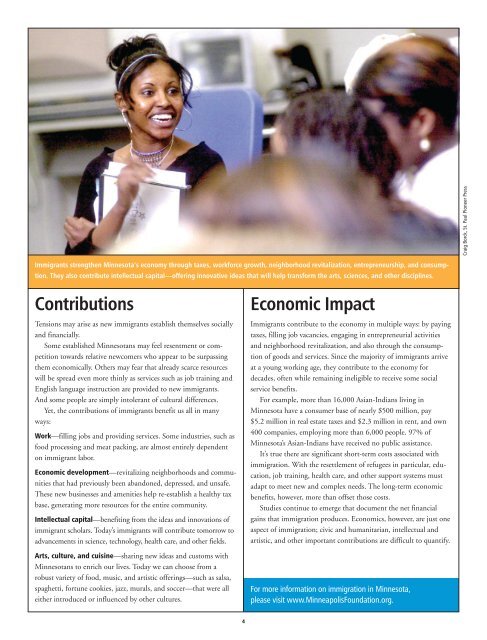Immigration in Minnesota - The Minneapolis Foundation
Immigration in Minnesota - The Minneapolis Foundation
Immigration in Minnesota - The Minneapolis Foundation
You also want an ePaper? Increase the reach of your titles
YUMPU automatically turns print PDFs into web optimized ePapers that Google loves.
Immigrants strengthen M<strong>in</strong>nesota’s economy through taxes, workforce growth, neighborhood revitalization, entrepreneurship, and consumption.<br />
<strong>The</strong>y also contribute <strong>in</strong>tellectual capital—offer<strong>in</strong>g <strong>in</strong>novative ideas that will help transform the arts, sciences, and other discipl<strong>in</strong>es.<br />
Contributions<br />
Tensions may arise as new immigrants establish themselves socially<br />
and f<strong>in</strong>ancially.<br />
Some established M<strong>in</strong>nesotans may feel resentment or competition<br />
towards relative newcomers who appear to be surpass<strong>in</strong>g<br />
them economically. Others may fear that already scarce resources<br />
will be spread even more th<strong>in</strong>ly as services such as job tra<strong>in</strong><strong>in</strong>g and<br />
English language <strong>in</strong>struction are provided to new immigrants.<br />
And some people are simply <strong>in</strong>tolerant of cultural differences.<br />
Yet, the contributions of immigrants benefit us all <strong>in</strong> many<br />
ways:<br />
Work—fill<strong>in</strong>g jobs and provid<strong>in</strong>g services. Some <strong>in</strong>dustries, such as<br />
food process<strong>in</strong>g and meat pack<strong>in</strong>g, are almost entirely dependent<br />
on immigrant labor.<br />
Economic development—revitaliz<strong>in</strong>g neighborhoods and communities<br />
that had previously been abandoned, depressed, and unsafe.<br />
<strong>The</strong>se new bus<strong>in</strong>esses and amenities help re-establish a healthy tax<br />
base, generat<strong>in</strong>g more resources for the entire community.<br />
Intellectual capital—benefit<strong>in</strong>g from the ideas and <strong>in</strong>novations of<br />
immigrant scholars. Today’s immigrants will contribute tomorrow to<br />
advancements <strong>in</strong> science, technology, health care, and other fields.<br />
Arts, culture, and cuis<strong>in</strong>e—shar<strong>in</strong>g new ideas and customs with<br />
M<strong>in</strong>nesotans to enrich our lives. Today we can choose from a<br />
robust variety of food, music, and artistic offer<strong>in</strong>gs—such as salsa,<br />
spaghetti, fortune cookies, jazz, murals, and soccer—that were all<br />
either <strong>in</strong>troduced or <strong>in</strong>fluenced by other cultures.<br />
4<br />
Economic Impact<br />
Immigrants contribute to the economy <strong>in</strong> multiple ways: by pay<strong>in</strong>g<br />
taxes, fill<strong>in</strong>g job vacancies, engag<strong>in</strong>g <strong>in</strong> entrepreneurial activities<br />
and neighborhood revitalization, and also through the consumption<br />
of goods and services. S<strong>in</strong>ce the majority of immigrants arrive<br />
at a young work<strong>in</strong>g age, they contribute to the economy for<br />
decades, often while rema<strong>in</strong><strong>in</strong>g <strong>in</strong>eligible to receive some social<br />
service benefits.<br />
For example, more than 16,000 Asian-Indians liv<strong>in</strong>g <strong>in</strong><br />
M<strong>in</strong>nesota have a consumer base of nearly $500 million, pay<br />
$5.2 million <strong>in</strong> real estate taxes and $2.3 million <strong>in</strong> rent, and own<br />
400 companies, employ<strong>in</strong>g more than 6,000 people. 97% of<br />
M<strong>in</strong>nesota’s Asian-Indians have received no public assistance.<br />
It’s true there are significant short-term costs associated with<br />
immigration. With the resettlement of refugees <strong>in</strong> particular, education,<br />
job tra<strong>in</strong><strong>in</strong>g, health care, and other support systems must<br />
adapt to meet new and complex needs. <strong>The</strong> long-term economic<br />
benefits, however, more than offset those costs.<br />
Studies cont<strong>in</strong>ue to emerge that document the net f<strong>in</strong>ancial<br />
ga<strong>in</strong>s that immigration produces. Economics, however, are just one<br />
aspect of immigration; civic and humanitarian, <strong>in</strong>tellectual and<br />
artistic, and other important contributions are difficult to quantify.<br />
For more <strong>in</strong>formation on immigration <strong>in</strong> M<strong>in</strong>nesota,<br />
please visit www.M<strong>in</strong>neapolis<strong>Foundation</strong>.org.<br />
Craig Borck, St. Paul Pioneer Press


